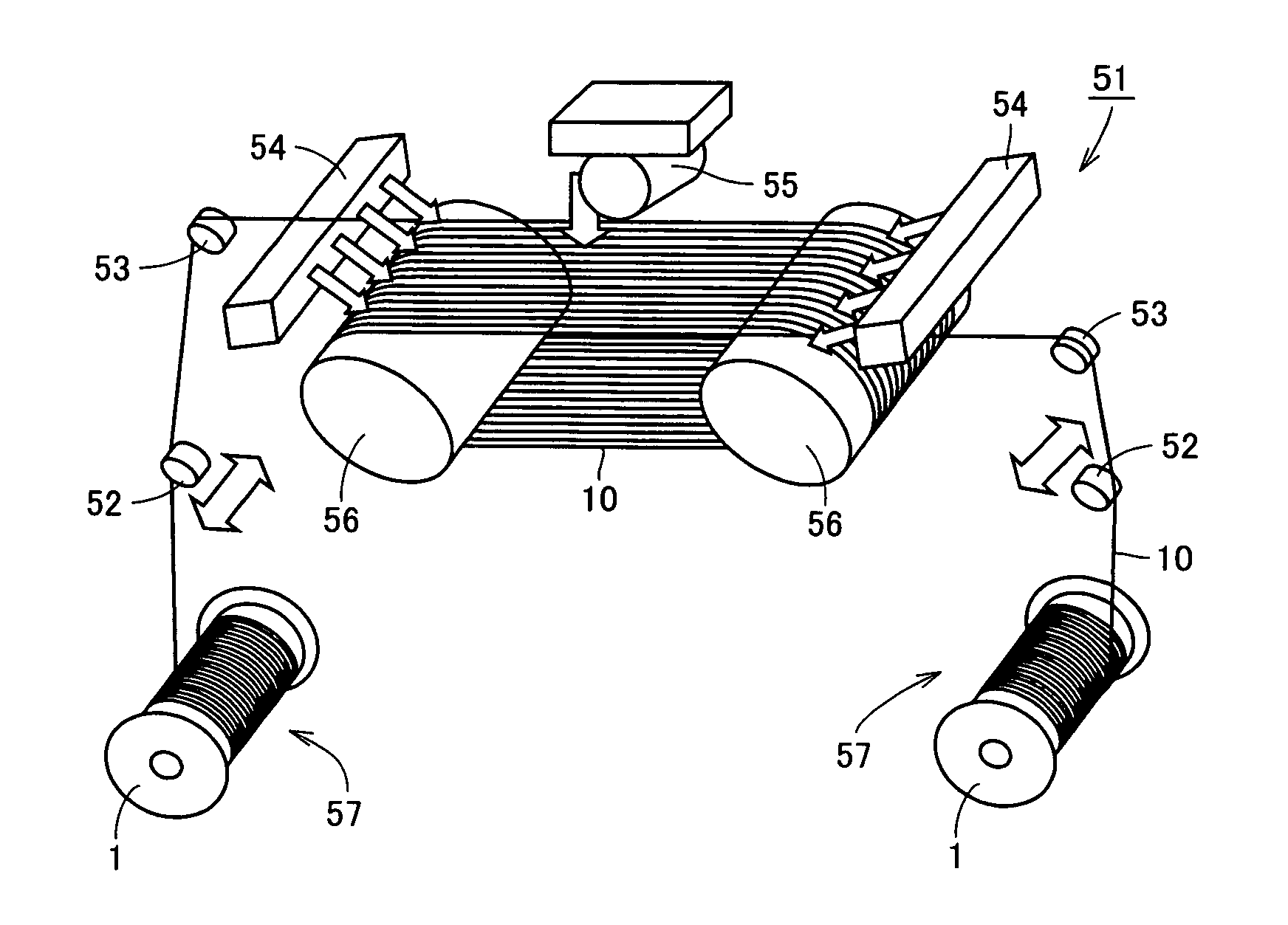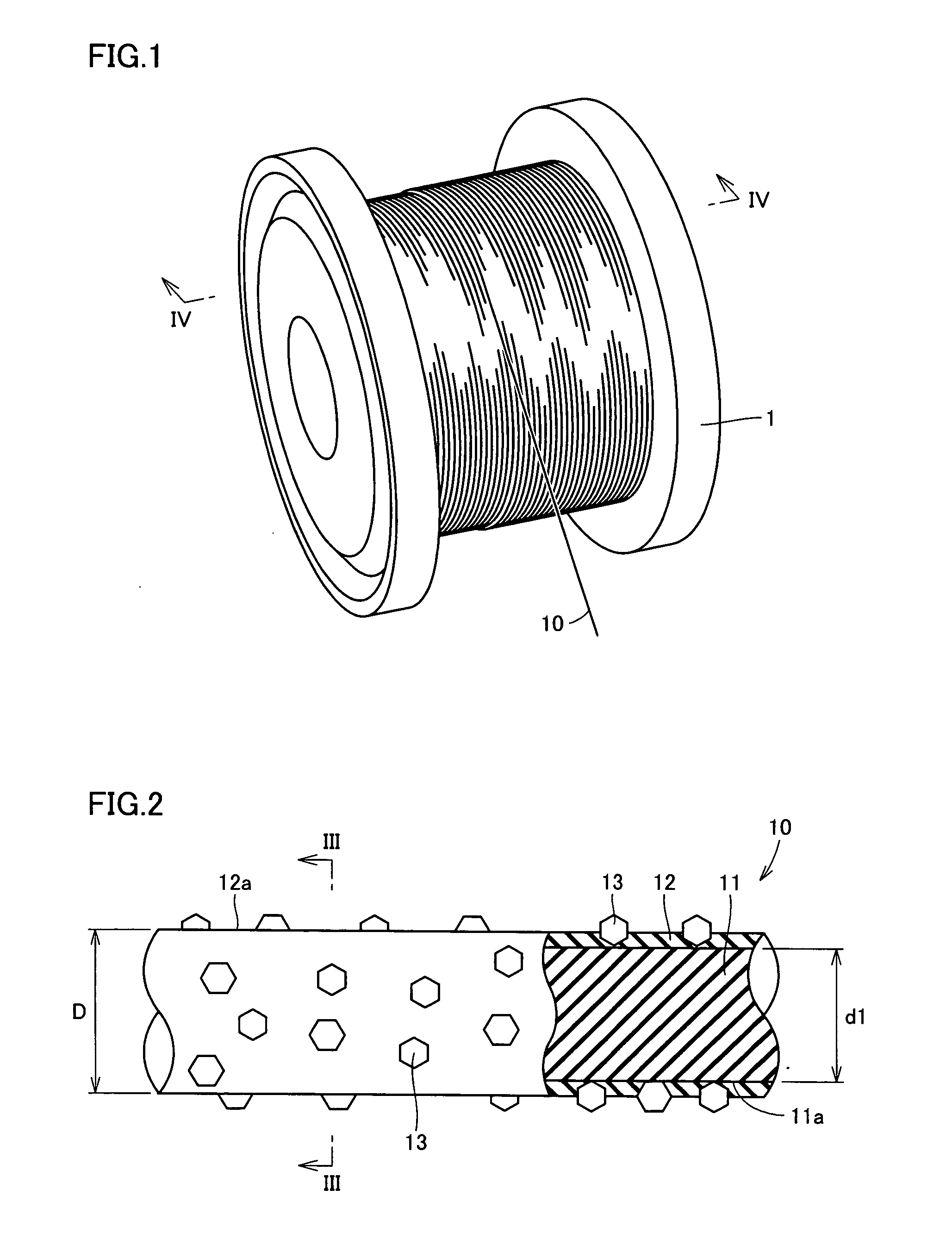Super abrasive grain wire saw winding structure, super abrasive grain wire saw cutting device, and super abrasive grain wire saw winding method
a super abrasive wire saw and cutting device technology, applied in the direction of metal sawing devices, saw chains, manufacturing tools, etc., can solve problems such as unreeled smoothly, and achieve the effects of preventing the engagement of superabrasive wire saws, reducing the damage to the bonding material and the falling of superabrasive grains, and preventing the friction between superabrasive wire saws
- Summary
- Abstract
- Description
- Claims
- Application Information
AI Technical Summary
Benefits of technology
Problems solved by technology
Method used
Image
Examples
example 1
[0065] By using cutting device 51 in FIG. 7, a test was conducted to examine influences of winding pitch P of superabrasive wire saw 10 on damage to bonding material 12 and falling of superabrasive grains 13. A piano wire having average diameter d1 of 0.18 mm was used as core wire 11 of superabrasive wire saw 10. Diamond superabrasive grains having average diameter d2 of 42 μm were used as superabrasive grains 13. A phenol resin was used as bonding material 12. Average diameter D of superabrasive wire saw 10 was 0.25 mm.
[0066] Under the test conditions below, there was conducted an unreeling test in which superabrasive wire saw 10 was repeated1y reciprocated between two reels 1.
[0067] Test Conditions:
[0068] Rate of superabrasive wire saw; 800 m / min
[0069] Winding tension T; 9.8N
[0070] Winding pitch P; 0.4 mm (D<P<2D)
[0071] Cutting fluid; water-soluble cutting fluid
[0072] Unreeling cycle (one reciprocation is defined as one cycle); 212 cycles
[0073] After the test, superabrasiv...
example 2
[0076] Next, by using superabrasive wire saw 10 specified similarly to that of example 1, an unreeling test was conducted under the test conditions below to examine the effects of the change in winding tension T of superabrasive wire saw 10. Note that a tensile test was performed on superabrasive wire saw 10 in advance, showing that the breaking strength thereof was 78N.
[0077] Test Conditions:
[0078] Rate of superabrasive wire saw; 800 m / min
[0079] Winding tension T; 9.8N (corresponding to 12.6% of the breaking strength of superabrasive wire saw 10)
[0080] Winding pitch P; 0.4 mm (D
[0081] Cutting fluid; water-soluble cutting fluid
[0082] Unreeling cycle; 424 cycles
[0083] After the test, the observation of superabrasive wire saw 10 as in example 1 showed that a cumulative peel length of bonding material 12 was 350 mm.
example 3
[0084] By using superabrasive wire saw 10 specified similarly to that of example 1, an unreeling test was conducted according to the test conditions of example 2 with the exception that only winding tension T thereamong was set to 25.7N (corresponding to 33% of the breaking strength of superabrasive wire saw 10). After the test, the observation of superabrasive wire saw 10 as in example 1 showed that a cumulative peel length of bonding material 12 was 2300 mm.
PUM
| Property | Measurement | Unit |
|---|---|---|
| angle | aaaaa | aaaaa |
| diameter d1 | aaaaa | aaaaa |
| diameter | aaaaa | aaaaa |
Abstract
Description
Claims
Application Information
 Login to View More
Login to View More - R&D
- Intellectual Property
- Life Sciences
- Materials
- Tech Scout
- Unparalleled Data Quality
- Higher Quality Content
- 60% Fewer Hallucinations
Browse by: Latest US Patents, China's latest patents, Technical Efficacy Thesaurus, Application Domain, Technology Topic, Popular Technical Reports.
© 2025 PatSnap. All rights reserved.Legal|Privacy policy|Modern Slavery Act Transparency Statement|Sitemap|About US| Contact US: help@patsnap.com



